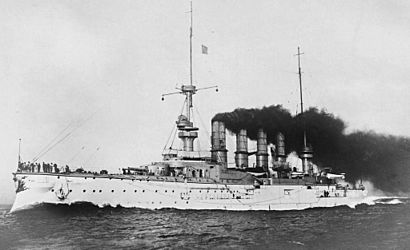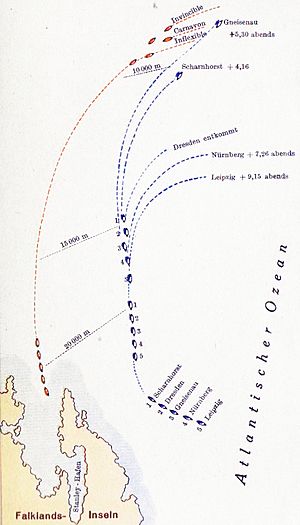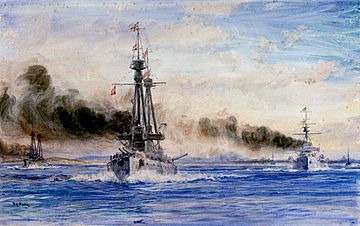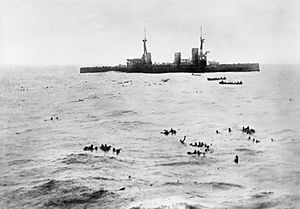Battle of the Falkland Islands facts for kids
Quick facts for kids Battle of the Falkland Islands |
|||||||
|---|---|---|---|---|---|---|---|
| Part of the First World War | |||||||
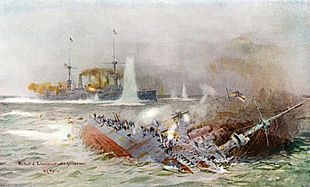 Battle of the Falkland Islands, William Lionel Wyllie |
|||||||
|
|||||||
| Belligerents | |||||||
| Commanders and leaders | |||||||
| Strength | |||||||
| 2 battlecruisers 3 armoured cruisers 2 light cruisers 1 armed merchant cruiser 1 grounded pre-dreadnought |
2 armoured cruisers 3 light cruisers 3 transport ships |
||||||
| Casualties and losses | |||||||
| 10 killed 19 wounded |
1,871 killed 215 captured 2 armoured cruisers sunk 2 light cruisers sunk 2 transports scuttled |
||||||
The Battle of the Falkland Islands was a big naval battle during the First World War. It happened on December 8, 1914, in the South Atlantic Ocean. The British Royal Navy fought against the Imperial German Navy.
The British had lost a battle earlier, called the Battle of Coronel. So, they sent a strong force to find and destroy the German cruiser squadron. This battle is remembered every year on December 8 in the Falkland Islands as a public holiday.
Admiral Graf Maximilian von Spee led the German ships. His squadron included two large armoured cruisers, SMS Scharnhorst and Gneisenau. There were also three smaller light cruisers: SMS Nürnberg, Dresden, and Leipzig. They also had three supply ships. Spee planned to attack the British supply base at Stanley in the Falkland Islands.
The British squadron had arrived in port the day before. It included two powerful battlecruisers, HMS Invincible and Inflexible. They also had three armoured cruisers, HMS Carnarvon, Cornwall, and Kent. Two light cruisers, HMS Bristol and Glasgow, and an armed merchant ship, HMS Macedonia, were also there.
The weather was perfect for a battle: clear skies, calm seas, and a gentle breeze. The British spotted the German ships early. By 9:00 AM, the British ships were chasing the Germans. Most of Spee's ships were caught and sunk, except for Dresden and one supply ship.
Contents
Why the Battle Happened
The British battlecruisers were much stronger than Spee's ships. Each British battlecruiser had eight 12-inch guns. Spee's best ships, Scharnhorst and Gneisenau, had eight 8.3-inch guns. The British ships were also faster. They could go 25.5 knots, while Spee's ships could only go 22.5 knots. This meant the British could both outgun and outrun the Germans. An old battleship, HMS Canopus, was placed on the shore at Stanley. It acted like a big gun battery to defend the area.
German Squadron's Journey
When World War I started, Admiral Spee's German East Asia Squadron was far from home. They were weaker than the British and Japanese navies in Asia. Spee knew he couldn't defend Germany's Asian lands. He decided to try and sail his ships back to Germany. He started by heading southeast across the Pacific Ocean.
Spee's fleet won a battle off Coronel, Chile, on November 1, 1914. His ships sank two British cruisers. After this victory, Spee's ships went to Valparaíso harbor in Chile. German people there welcomed them as heroes. But Spee was not celebrating. When offered flowers, he said, "these will do nicely for my grave." This showed he knew the dangers ahead.
His officers wanted to return to Germany. The squadron had used half its ammunition at Coronel. They couldn't get more, and it was hard to find coal for their ships. Spee heard that British warships were not at Stanley. He was worried about the British battleship Canopus, but didn't know where it was.
On December 6, Spee decided to attack the Falkland Islands. Most of his captains disagreed. They had enough coal and the raid seemed risky. But Spee decided to go ahead anyway.
British Preparations
The British Admiralty quickly reacted to their defeat at Coronel. On November 3, they learned Spee was near Valparaíso. They decided to send strong reinforcements. Two powerful battlecruisers, Invincible and Inflexible, were ordered to sail to the South Atlantic.
Vice-Admiral Doveton Sturdee was put in charge of this new squadron. He left Devonport on November 11. Even though they were in a hurry, the ships had to sail slowly. This was to save coal for the long journey. The mission was kept secret to surprise Spee.
Sturdee's ships arrived at the Falkland Islands on the morning of December 7. The two light cruisers docked inside Stanley Harbour. The bigger ships stayed in the deeper outer harbor of Port William. Divers worked to fix a problem with Invincible's propeller. Other ships were also getting repairs or taking on coal.
An unexpected source helped the British. Mrs. Muriel Felton, who lived on a sheep farm, and her maids spotted the German ships. They used a telephone to tell Port Stanley about the ships' movements. This helped the British ships get into the best positions. Mrs. Felton later received an award for her actions.
The Battle Begins
First Moves
Spee's cruisers, Gneisenau and Nürnberg, were the first to approach Stanley. Most of the British fleet was taking on coal. But they could get ready to sail quickly. Some people think Spee could have attacked them easily. However, two British ships were already on guard, and the battleship HMS Canopus was also there.
The Germans were surprised when Canopus started firing. This old battleship was hidden behind a hill. Its unexpected gunfire stopped the German advance. Then, the Germans saw the tall masts of the British battlecruisers. They knew they were facing a much stronger enemy. HMS Kent was already leaving the harbor to chase Spee's ships.
Admiral Sturdee knew the Germans were there. He ordered his crews to eat breakfast. He knew Canopus had bought them time to get their ships ready.
Spee realized his danger too late. His crews were tired, and his ships were outmatched. He had lost his chance to attack the British in port. Spee and his squadron quickly sailed for the open sea. The British ships left port around 10:00 AM. Spee was about 15 miles ahead. But the faster British battlecruisers had plenty of daylight to catch up.
The Main Fight
At 1:00 PM, the British battlecruisers opened fire. It took them about 30 minutes to hit SMS Leipzig. Spee knew he couldn't outrun the British. He decided to fight with his two armoured cruisers. This would give his lighter ships a chance to escape. He turned his ships to fight just after 1:20 PM.
The German ships had an advantage from the wind. The smoke from the British ships' funnels blocked their view. Even so, the British ships, Invincible and Inflexible, were too powerful. They hit Scharnhorst and Gneisenau many times.
SMS Scharnhorst, Spee's main ship, was badly damaged. Its funnels were flattened, and it caught fire. It began to tilt more and more. At 4:17 PM, Scharnhorst sank, taking Admiral Spee and everyone on board with it.
SMS Gneisenau kept fighting until 5:15 PM. By then, it had run out of ammunition. It sank at 6:02 PM. The British rescued 190 of Gneisenau's crew from the water. The British battlecruisers were hit about 40 times. But only one British crewman was killed, and four were injured.
Meanwhile, SMS Nürnberg and SMS Leipzig tried to escape the British cruisers. HMS Kent chased Nürnberg. Nürnberg was going at full speed but needed repairs. HMS Kent's crew pushed their engines to the limit. Nürnberg finally turned to fight at 5:30 PM. HMS Kent had stronger guns and better armor. Nürnberg had two boiler explosions around 6:30 PM. This made Kent faster and more agile. The German ship rolled over and sank at 7:27 PM.
HMS Glasgow and HMS Cornwall chased SMS Leipzig. Leipzig ran out of ammunition but kept its battle flag flying. Glasgow stopped firing when Leipzig sent up two flares. At 9:23 PM, Leipzig also rolled over and sank. Only 18 survivors were found.
During the battle, the British also sent ships to destroy the German supply ships. HMS Bristol and HMS Macedonia chased and sank two of them, Baden and Santa Isabel, at 7:00 PM. The crews were rescued first. One supply ship, Seydlitz, managed to escape.
What Happened After
The battle had a very clear winner. The British had very few casualties. Admiral Spee and his two sons were among the many Germans who died. The British rescued 215 German survivors. They became prisoners on the British ships. Most were from Gneisenau. Scharnhorst sank with everyone on board.
Of the eight German ships, only two escaped. These were the supply ship Seydlitz and the light cruiser Dresden. Dresden roamed the seas for three more months. But on March 14, 1915, British ships found it. After a short fight, Dresden's captain sank his own ship.
Because of this battle, the German East Asia Squadron was destroyed. Germany could no longer send regular warships to attack trade ships on the high seas.
British Secret Information
After the battle, German naval experts wondered why Admiral Spee attacked the Falklands. They also wondered how the two groups of ships met in such a huge ocean. Even Kaiser William II wrote that it was a "mystery."
It was thought that Spee was tricked by German intelligence. They told him the port was clear of British warships. But in 1925, a German naval officer learned the truth. He spoke with Admiral William Reginald Hall, who led British naval intelligence. Hall told him that the British had broken a German naval code. They sent a fake signal to lure Spee's squadron towards the British battlecruisers. This secret code-breaking also helped the British find Dresden later.
Scharnhorst Wreck Found
The wreck of Scharnhorst was found on December 4, 2019. It was about 98 nautical miles southeast of Stanley. The ship rests at a depth of 1,610 meters (about a mile deep).
Images for kids


